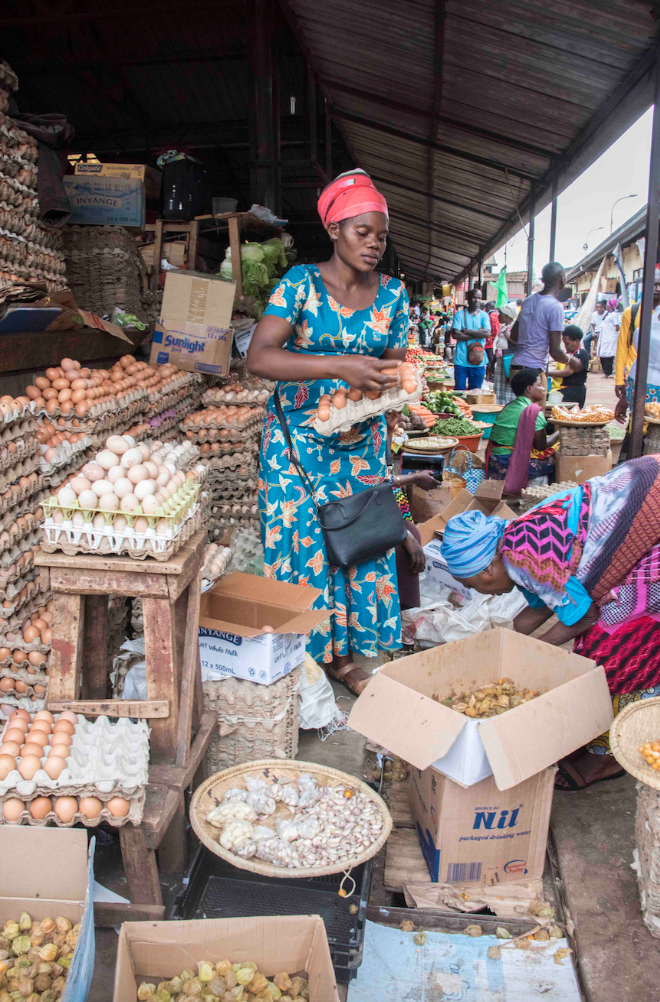
Featured image: A vendor sold eggs in the front of the market. The overwhelming majority of shopkeepers were female.
[hr]
By Madelyn Kumar
[divider]
[dropcap]I[/dropcap]t was the fifth day in Kigali, and I was the only one who had not yet paid a visit to the Kimironko market. This was surprising for two reasons: 1) the market was usually my first stop in a foreign country; and 2) I am a self-proclaimed shopping enthusiast (which is one tenuous title away from a shopaholic).
I grew up watching my mother’s artful negotiations with Asian shopkeepers. She would animatedly argue with the shopkeeper that another vendor was selling the product for half the price, then coolly stroll away. Without fail, the vendor would dart after her and beckon her return with a defeated handwave. My mom taught me to master this craft: set a maximum price and never exceed it, look at the zippers and threads as telltale signs for quality, and ask yourself, “can I really not find this anywhere else?” With these tenants of market transaction in mind, I decided to test my proficiency at the busiest market in town: Kimironko.
[divider]

An action shot of me bargaining for two engraved coconut candle holders. Two cost 4,000 RWF. (Photo credit: Hadley Copeland)
[divider]
At this point in the trip, I had resorted to using motorcycles as my main form of transportation because they were five times cheaper than taking a taxi. (Don’t worry Mom and Dad, a loose helmet was provided that I could hold in place on my skull.) Kigali’s urban landscape unfolded as we sped down the freeway. The symphony of engines and scent of oil hung heavily in the air as we wove in and out of traffic. Overall, 1,000 Rwandan franc (RWF) (about 1 USD) was a stellar price for a scenic view and ten kilometers of travel.
Just like how you can learn about a person by looking into her eyes, you can discover a lot about a city by exploring her markets. Kimironko was a sprawling marketplace metropolis housed in a hallowed warehouse. On the journey through the market, I passed radiating banana bunches, cardboard egg crates laid like brickwork, a jungle of hanging kitenge fabrics stretching up to the canopy (read: to the 30 foot roof), colorful arrays of beaded earrings, and bright African baskets with spiraling, geometric patterns. Locals and tourists alike conversed with vendors to hunt for souvenirs or haggle for fresh local produce. These vendors, most working from 8:00 A.M. to just before 8:00 P.M., were some of the hardiest, most charming people I have met: relentless but kind, expedient but patient.
[divider]

Two vendors sat behind mounds of dried fish. Shops usually specialized in selling one type of food.
[divider]
When my friend and I entered the market, we were greeted by enthusiastic invitations of “Sister! Sister! Come to my store please!” and “My friend, look at my work!” We were also led by children through the maze of vendors to their family shops. My favorite section of Kimironko was the custom clothing service, which was encircled by kitenge, an East African batik-dyed fabric that uses wax to create empty space and patterns on the cloth. Kitenage was traditionally dyed by women, and is the main fabric choice for female Rwandans.
The day before, I had come to Kimironko and spotted a beautiful dotted kitenge fabric. At that time, Bruno—a vendor about my age—offered me a well-worn catalog of models sporting various tailoring styles. He measured me for a long skirt, typed his WhatsApp contact into my phone, and told me to find him tomorrow at the Kimironko for the exchange—he had done all this in about thirty seconds. It took ten minutes of intense negotiation to lower the price from 35,000 to 10,000 RWF. If the average national Rwandan salary is about 16,770,000 RWF, Bruno would have to sell between four and five pieces at 10,000 RWF every day. On the day I spoke to him, he sold ten pieces and planned to sell five pieces the next day.
[divider]

Two kitenge vendors enjoyed a lunch break in the middle of their shop.
[divider]
The next afternoon, I showed the surrounding vendors Bruno’s WhatsApp contact photo. A little boy exclaimed, “Bruno!” and guided me to his stall where a beautiful blue skirt awaited me. Easily one of the best shopping decisions I have made. Subsequently, I ordered two more custom pants (20,000 RWF each) from Esperance, a competing tailor from a different stall who had a wide selection of pants styles. It was clear that Esperance was a seasoned pro by the way she made suggestions for the best fit for certain fabrics.
Esperance told me that she would need three hours to finish my garments. While waiting, I wandered around other stalls and began to accumulate locally-made momentos, jewelry, ties, and woven bowl baskets. Bargaining with vendors released the familiar adrenaline rush when I closed in on my target price. But, I also asked myself if it was justifiable (morally and economically) to be haggling over 30 cents.
[divider]

Sewers created clothing pieces from the fabrics customers selected. They lined the perimeter of the kitenge fabric stalls.
[divider]
After four hours, 40,500 RWF, and a fruitful haul of 12 items, I quickly motorcycled back to repack my suitcase before the flight. It took twenty minutes of strategic puzzle placement, tightly rolling shirts around the coconut holders, and a sacrificial pair of shoes for everything to fit.
[divider]

I sported my new kitenge pants for the last group dinner. (Photo credit: Hadley Copeland)
[divider]
If you are travelling to Kigali, be sure to leave ample luggage space, take a wad of cash, and clear out three hours for Kimironko Market.
[hr]
Madelyn Kumar is a junior in Silliman College. You can contact her at madelyn.kumar@yale.edu.